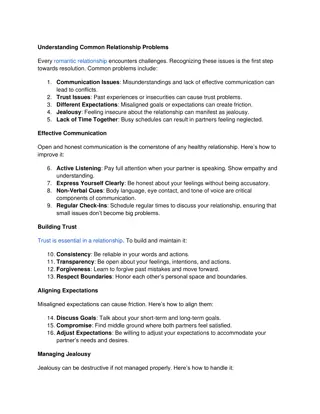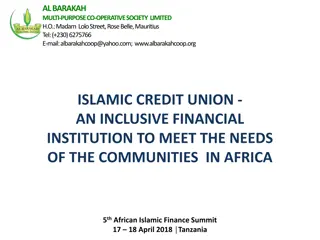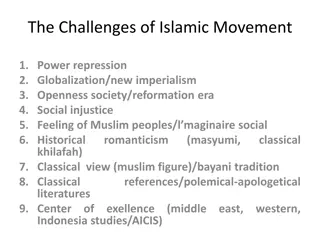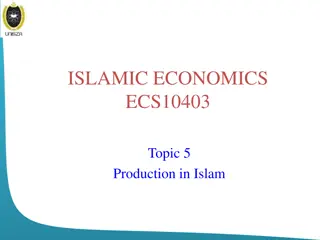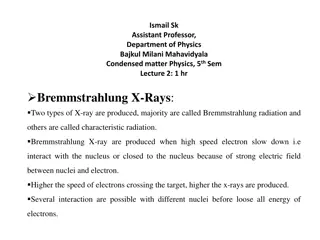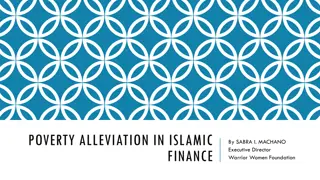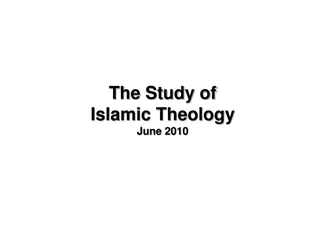
Main Terms of Islamic Law and Its Characteristics
Explore the key terms of Islamic Law such as hukum, hukm, ahkam, syariah, and fiqh. Delve into the concepts of hukum as law, the base structure set by Allah SWT, and the principles of hukm and ahkam in Islamic Law.
Download Presentation

Please find below an Image/Link to download the presentation.
The content on the website is provided AS IS for your information and personal use only. It may not be sold, licensed, or shared on other websites without obtaining consent from the author. If you encounter any issues during the download, it is possible that the publisher has removed the file from their server.
You are allowed to download the files provided on this website for personal or commercial use, subject to the condition that they are used lawfully. All files are the property of their respective owners.
The content on the website is provided AS IS for your information and personal use only. It may not be sold, licensed, or shared on other websites without obtaining consent from the author.
E N D
Presentation Transcript
THE MAIN TERM THE MAIN TERM OF ISLAMIC LAW OF ISLAMIC LAW AND AND THE CHARACTERISTIC THE CHARACTERISTIC OF ISLAMIC LAW OF ISLAMIC LAW INTERNATIONAL CLASS-FHUI
In Islamic law, we have to be able to differentiate these main terms: 1. hukum 2. hukm and ahkam 3. syariah or syariat 4. fiqh INTERNATIONAL CLASS-FHUI
(1) Hukum (Law) Simply, hukum (law) is a set of norms that governs the human behaviour in the society, consist of the law that grew and developed in the society and the law that made with any method and enforced by the government. The form of the law may be unwritten like the custom law, or written like the western law. The law in the conception of western law is the law that made by human to govern their interests in the society. In this conception, the law governs the human relationship with other human and the objects in the society. INTERNATIONAL CLASS-FHUI
In Islamic Law, the base concept and structure is set by Allah SWT. It governs not only human relationship with other human and the objects in the society, but also other type of relationships, considering that human in his life has various relationships: human and God, human and his self, human with other human, human with the objects in the society and the environment around him. These various of interactions regulated by a set of behaviour measurement (singular), ahkam (plural). that called hukm INTERNATIONAL CLASS-FHUI
(2) Hukm and Ahkam The Indonesan word hukum derived from the Arabic word hukm . principle, that is the measure, measure standard, standard rule, directory that used to appraise the behaviour of human and objects. It means the norm, the In the system of Islamic Law, there are five hukm that used to measure human behaviour in the field of ibadah (worship) and muamalah. INTERNATIONAL CLASS-FHUI
These five principles called al-ahkam al-khamsah or the five classification of law (Sajuti Thalib, 1985: 16), meanwhile in Islamic bibliography, it is called taklifi law (Masyfuk Zuhdi, 1987: 5). Ja iz or Mubah or Ibahah Sunnat al-Ahkam al-Khamsah Makruh Wajib Haram INTERNATIONAL CLASS-FHUI
(3) Syariat Syariat means the way to the fountain, the straight way that must be followed by every Muslim. Syariat contains Allah s and the Prophet s wills. INTERNATIONAL CLASS-FHUI
(4) Fiqh Fiqh means understanding. The science of fiqh is the science that determine and clarify the basic norms in the Al Qur an and Hadits. This science helps us to understand the law in the Al Qur an and as-Sunnah, so that the law can be implemented in mature and healthy (mukallaf) human s responsible to do the Islamic law. Then, the result of understanding process about Islamic law prepared systematically in fiqh books and called fiqh law (Islamic jurisprudence). behaviour who INTERNATIONAL CLASS-FHUI
The Differences Between Syariat and Fiqh 1. Syariat lies in Al Qur an and Hadits. It means, syariat is the revelation of Allah SWT and the Sunnah of Muhammad SAW. Meanwhile, fiqh lies in the fiqh books. Fiqh is the understanding of qualified person about syariat and the result of his understanding. 2. Syariat is fundamental and has a larger scope, considering that the experts put aqidah and akhlaq into syariat. Meanwhile, fiqh is instrumental and has a limited scope in the law which governs the human behaviour that usually called legal act. INTERNATIONAL CLASS-FHUI
3. Syariat is the provision of Allah SWT and the provision of His Prophet, so syariat is everlasting. Meanwhile, fiqh is the human creation which is not eternal and could be changed from time to time. 4. Syariat is solus, meanwhile fiqh perhaps more than one. For example, the mazhab. 5. Syariat shows the unity of islam,meanwhile fiqh shows the diversity.. (Asaf A.A. Fyzee, 1955: 17, H.M. Rasjidi, 1958: 403, Ahmad Ibrahim, 1965: 2, M. Khalid Masud, 1977: 22, S.H. Nasr, 1981: 60,Masyfuk Zuhdi, 1987: 1) INTERNATIONAL CLASS-FHUI
The Differences Between Syariat and Fiqh SYARIAT FIQH Syariat lies in Al Qur an and Hadits. It means, syariat is the revelation of Allah SWT and the Sunnah of Muhammad SAW. fiqh lies in the fiqh books. Fiqh is the understanding of qualified person about syariat and the result of his understanding. Syariat is fundamental and has a larger scope, considering that the experts put aqidah and akhlaq into syariat. fiqh is instrumental and has a limited scope in the law which governs the human behaviour that usually called legal act. Syariat is the provision of Allah SWT and the provision of His Prophet, so syariatis everlasting , fiqh is the human creation which is not eternal and could be changed from time to time. Syariat is solus from Allah SWT, fiqh perhaps more than one. For example, the mazhab. Syariat shows the unity of Islam fiqh shows the diversity.. INTERNATIONAL CLASS-FHUI
THE CHARACTERISTIC OF ISLAMIC LAW 1. It is the part and based on Islamic religion. 2. It has a tight and inseparable relationship with Islamic faith (aqidah) and ethics (akhlaq). 3. It has two keywords: (a) syariat and (b) fiqh. 4. It contains of two main fields: (a) worship (ibadah), and (b) muamalah in large scope. INTERNATIONAL CLASS-FHUI
5. It is stratified that contains of: (a) nas or the text of Al Qur an, (b) Sunnah (for syariat), (c) the result of the ijtihad by the qualified person about the revelation and Sunnah, (d) the practical implementation in (i) decision of judge or (ii) practices by the adherent of Islam in the society (for fiqh). 6. Precede the responsibilities/obligation from the rights. INTERNATIONAL CLASS-FHUI
1. 7. It can be divided into (a) taklifi law (al-Ahkam al-Khamsah), and (b) wadh i law that contains the reason, conditions, obstruction of the occurs or the establishment of legal relationships. 8. It is universal, stand for everlasting time for the adherent of Islam wherever and whenever. 9. It respects human dignity as an unity of soul and body, spiritual and physical, and humanity as a whole. 10. Its practical implementation moved by faith (aqidah) and akhlaq of the adherent of Islam. INTERNATIONAL CLASS-FHUI





